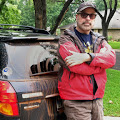|
Martin Lisius  Martin Lisius is an American filmmaker[1] and storm chaser.[2][3] He founded StormStock,[4] a weather and climate stock footage collection, in 1993, and Tempest Tours,[5] a storm chasing expedition company, in 2000. In 2018, he produced and directed the short film, Prairie Wind, among the first known 16K resolution videos to exist.[6] In 1993, Lisius founded the Texas Severe Storms Association (TESSA), a non-profit whose mission is "to bring together both professional meteorologists and weather enthusiasts in an attempt to better understand dangerous storms through the collection and diffusion of knowledge." Lisius was a finalist for 2023 Footage Person of the Year,[7] an award presented by FOCAL International. Lisius is listed on the Notable Alumni web page for the Department of Communication at the University of Texas at Arlington.[8] Tempest ToursIn 2000, Lisius founded an experiential travel company called Tempest Tours. The company provides storm chasing expeditions to paying guests.[9] Expeditions take place in the US Great Plains region of Tornado Alley during the active spring storm season there. The company is staffed primarily by veteran storm chasers, first responders, and meteorologists. Research meteorologist Charles A. Doswell IIl was an early member of the staff working as a lecturer. StormStockStormStock is a collection of weather and climate stock footage and a brand of Prairies Pictures, Inc. that Lisius founded in 1993. Lisius and a staff of videographers track and film severe weather, such as hurricanes and tornadoes, and license the content for use in TV and film productions.[10] Public SafetyLisius founded the Texas Severe Storms Association (TESSA), a 501(c)3 non-profit, in 1993 to bring meteorologists and storm chasers together and help disseminate their information to the public. TESSA hosts the National Storm Conference where presentations about severe weather are presented by experts. As TESSA chairman, Lisius co-developed the DFW Tornado Scenario with National Weather Service Ft. Worth meteorologists Alan Moller, Gary Woodall, and Bill Bunting in 2000. Later, North Central Texas Council of Governments analyst Scott Rae created detailed versions of the scenario titled, Tornado Damage Risk Assessment.[11] Their objective was to create scientific scenarios in which major tornadoes tracked through the Dallas-Ft. Worth Metroplex in order to be better prepared for those potentially catastrophic events. Lisius published a book in 2014 titled, "The Ultimate Severe Weather Safety Guide."[12] In the book, he states his purpose for writing it is to share what he has learned as a storm chaser to help others stay safe when severe weather threatens. Chapters include safety tips for tornadoes, lightning, hurricanes and flash flooding. In an attempt to demonstrate the danger of flying debris in a tornado, Lisius took some common household objects to the Debris Impact Facility at Texas Tech University in Lubbock to be launched by their pneumatic cannon in 2019. One object, a small handheld camera, became the fastest projectile to be tested at the facility reaching a speed of 264 mph.[13] FilmographyIn 1995, Lisius directed "StormWatch," a training video for the National Weather Service used nationwide to train storm spotter groups. Lisius co-produced the video with meteorologists Gary Woodall and Alan Moller. It was produced by the Texas Severe Storms Association with support from the Meadows Foundation of Dallas, Texas. In 1996, Lisius wrote and directed "The Chasers of Tornado Alley," an early documentary film about storm chasing.[14] In 2018, Lisius shot a short film titled, "Prairie Wind" with a 16K video camera system he custom-built.[15] In 2024, Lisius wrote and directed "The Chasers of Tornado Alley: Touching the Sky," a sequel to the 1996 documentary about storm chasing. The film was shot on 4K and 16K video, and on Super 35mm motion picture film.[16] Notable storm interceptsJune 8, 1995 Pampa - Hoover, Texas tornadoes, F4-F5.[17] May 30, 1998 Spencer, South Dakota Tornado, F4.[18] Hurricane Katrina (Category 5) Mississippi - Louisiana coastal landfall, August 29, 1995. Hurricane Harvey, Southeast Texas, August 2017.[19] Lisius' aerial footage of Hurricane Harvey appears in his short film, "Buffalo Bayou Rising," an official selection by the 2017 Flying Robot International Film Festival.[20] References
|